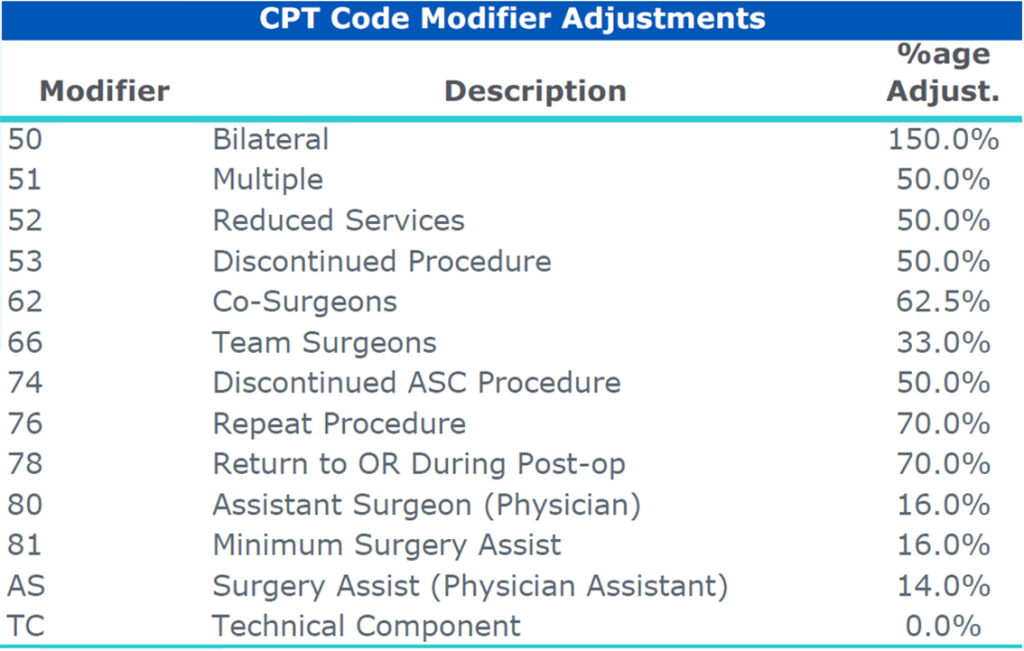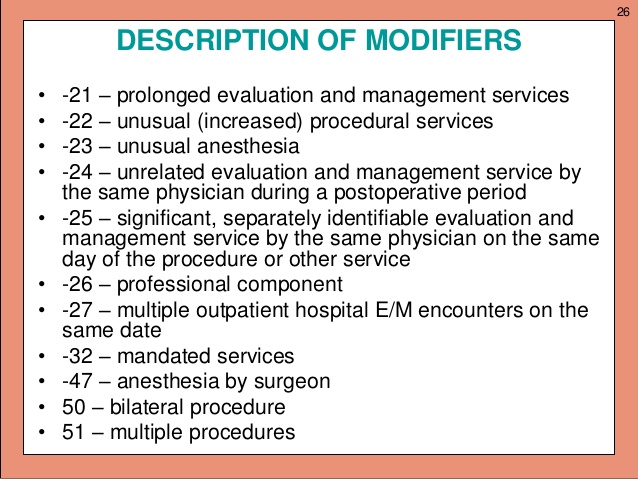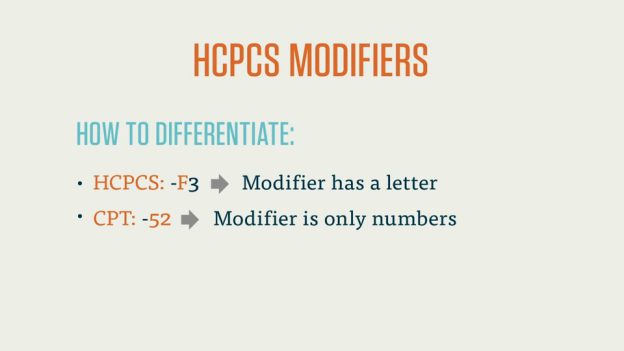In the world of medical billing, understanding the various types of modifiers is crucial for accurate and efficient processing of claims. Modifiers play a significant role in defining the specific circumstances and conditions of a medical procedure or service. By appending the appropriate modifier to a claim, healthcare providers can ensure rightful reimbursement and avoid potential denials or inaccuracies. This article will explore the different types of modifiers commonly used in medical billing, shedding light on their purpose and significance in the intricate world of healthcare reimbursement.
Modifiers in Medical Billing
Modifiers play a crucial role in medical billing, allowing healthcare providers to accurately communicate the specific circumstances of a procedure or service to insurance payers. These modifiers consist of a two-digit code appended to a CPT (Current Procedural Terminology) code, providing additional information about the nature of the procedure or service performed. Understanding the various types of modifiers is essential for healthcare professionals involved in medical billing, ensuring proper reimbursement and avoiding potential claim denials. In this article, we will explore the different types of modifiers used in medical billing, their importance, and their specific purposes in various healthcare settings.
Evaluation and Management Modifiers
Evaluation and Management (E&M) services are essential components of medical practice, involving the assessment, diagnosis, and management of patients. Modifiers associated with E&M services serve to highlight unique circumstances or significant aspects of these encounters. Three commonly used E&M modifiers include Modifier 25, Modifier 57, and Modifier 59.
- Modifier 25: Significant, Separately Identifiable Evaluation and Management Service by the Same Physician on the Same Day of the Procedure Modifier 25 is used when a significant E&M service is provided by the same physician on the same day as a procedure. This modifier ensures that the E&M service is recognized and reimbursed separately from the procedure.
- Modifier 57: Decision for Surgery Modifier 57 indicates that the E&M service resulted in the decision to perform surgery, highlighting the vital role of the physician’s evaluation and decision-making process. This modifier helps prevent bundling of the E&M service with the subsequent surgical procedure.
- Modifier 59: Distinct Procedural Service Modifier 59 is commonly used to identify procedures or services that are distinct and separate from each other, preventing them from being bundled into a single reimbursement. This modifier is particularly useful for situations where multiple procedures are performed during the same encounter, but each procedure has a distinct purpose or anatomical location.

This image is property of www.veralon.com.
Surgical Modifiers
surgical modifiers are essential in medical billing to accurately describe various aspects of surgical procedures. These modifiers provide important details, such as increased complexity, postoperative management, and unexpected returns to the operating room. Common surgical modifiers include Modifier 22, Modifier 24, and Modifier 78.
- Modifier 22: Increased Procedural Service Modifier 22 is used when a procedure requires additional work beyond the typical circumstances outlined in the CPT code description. This modifier is appropriate when a procedure entails increased complexity, increased intensity, or additional time and effort on the part of the physician.
- Modifier 24: Unrelated Evaluation and Management Service by the Same Physician During a Postoperative Period Modifier 24 is used to indicate that an unrelated evaluation and management service was provided by the same physician during a postoperative period. This modifier ensures that the physician is appropriately reimbursed for any additional services rendered during this period that are not directly related to the surgical procedure.
- Modifier 78: Unplanned Return to the Operating/Procedure Room by the Same Physician or Other Qualified Healthcare Professional Following Initial Procedure for a Related Procedure Modifier 78 is used to signify an unplanned return to the operating/procedure room by the same physician or other qualified healthcare professional for a related procedure. This modifier ensures that the subsequent procedure is recognized and reimbursed separately from the initial procedure.
Anesthesia Modifiers
Anesthesia services require specific modifiers to accurately document the involvement of the surgeon and any unexpected circumstances that may arise during the procedure. Two important anesthesia modifiers are Modifier 47 and Modifier 53, along with the previously discussed Modifier 78 in the surgical section.
- Modifier 47: Anesthesia by Surgeon Modifier 47 indicates that the surgeon provided the anesthesia during a surgical procedure. This modifier is used in situations where the surgeon, rather than an anesthesiologist or certified registered nurse anesthetist, administers the anesthesia.
- Modifier 53: Discontinued Procedure Modifier 53 is used when a procedure is started but discontinued due to extenuating circumstances or patient factors that prevent its completion. This modifier allows for appropriate reimbursement for the portion of the procedure performed.
- Modifier 78: Return to the Operating/Procedure Room for a Related Procedure During the Postoperative Period As mentioned earlier in the surgical section, Modifier 78 is used when there is an unplanned return to the operating/procedure room for a related procedure during the postoperative period.
Radiology Modifiers
Modifiers in radiology billing help differentiate between the professional and technical components of a radiology service or identify distinct procedural services. The two primary radiology modifiers are Modifier 26 and Modifier TC, along with the previously discussed Modifier 59 used for distinct procedural services.
- Modifier 26: Professional Component Modifier 26 is used to indicate that the healthcare professional provided only the professional component of a radiology service, such as interpreting and providing a written report. This modifier ensures appropriate reimbursement for the professional component alone.
- Modifier TC: Technical Component Modifier TC indicates that the healthcare professional provided only the technical component of a radiology service, such as the equipment, facilities, and technician that performed the imaging. This modifier ensures appropriate reimbursement for the technical component alone.
Pathology and Laboratory Modifiers
Pathology and laboratory services require specific modifiers to indicate certain circumstances, such as reference to outside laboratories, repeat tests, and the use of multiple modifiers. Commonly used pathology and laboratory modifiers include Modifier 90, Modifier 91, and Modifier 99.
- Modifier 90: Reference (Outside) Laboratory Modifier 90 is used when laboratory testing is performed by an outside laboratory, rather than in-house. This modifier ensures appropriate reimbursement for the use of external laboratory services.
- Modifier 91: Repeat Clinical Diagnostic Laboratory Test Modifier 91 is used when a laboratory test is repeated on the same patient, same day, and same encounter. This modifier assists in accurate reimbursement for repetitive tests that provide essential diagnostic information.
- Modifier 99: Multiple Modifiers Modifier 99 is used when multiple modifiers are necessary to fully describe a procedure or service. This modifier helps eliminate any confusion or potential coding errors due to the use of multiple modifiers.

This image is property of upload.orthobullets.com.
Medicine Modifiers
Medicine modifiers are essential for accurately coding and billing for a wide range of medical services and procedures. These modifiers are used to indicate multiple outpatient encounters, distinct procedural services, and repeat procedures. Notable medicine modifiers include Modifier 27, Modifier 59, and Modifier 76.
- Modifier 27: Multiple Outpatient Hospital E/M Encounters on the Same Date Modifier 27 is used when multiple Evaluation and Management encounters occur in an outpatient hospital setting on the same date. This modifier ensures appropriate reimbursement for each separate E&M encounter.
- Modifier 59: Distinct Procedural Service As previously discussed in the evaluation and management and radiology sections, Modifier 59 is also used in medicine billing to identify distinct procedural services. It prevents inappropriate bundling of procedures that are separate and independently reportable.
- Modifier 76: Repeat Procedure or Service by Same Physician or Other Qualified Healthcare Professional Modifier 76 is used when the same physician or other qualified healthcare professional performs a repeat procedure or service. This modifier ensures proper reimbursement for subsequent procedures or services necessary for the patient’s care.
Physical Therapy Modifiers
Physical therapy services require specific modifiers to accurately depict the delivery of outpatient physical therapy, occupational therapy, and speech-language pathology care. These modifiers differentiate between the various types of therapy plans. Key physical therapy modifiers include Modifier GP, Modifier GO, and Modifier GN.
- Modifier GP: Services Delivered Under an Outpatient Physical Therapy Plan of Care Modifier GP is used to indicate that services were delivered under an outpatient physical therapy plan of care. This modifier ensures accurate billing for physical therapy services performed and helps differentiate them from other types of therapy services.
- Modifier GO: Services Delivered Under an Outpatient Occupational Therapy Plan of Care Modifier GO is used when services are delivered under an outpatient occupational therapy plan of care. This modifier facilitates proper reimbursement for occupational therapy services provided and distinguishes them from other therapy services.
- Modifier GN: Services Delivered Under an outpatient speech-language pathology plan of care Modifier GN is used to indicate that services were delivered under an outpatient speech-language pathology plan of care. This modifier ensures accurate billing for speech-language pathology services performed and differentiates them from other therapy services.
Ambulance Modifiers
Ambulance services also require specific modifiers to properly describe the type of item or service provided and the expectation of payment denial. The two key ambulance modifiers are Modifier GY and Modifier GZ.
- Modifier GY: Item or Service Statutorily Excluded, Does Not Meet the Definition of Any Medicare Benefit or for Non-Medicare Insurers, is Not a Contractual Benefit Modifier GY is used to indicate that the item or service provided is statutorily excluded and does not meet the definition of any Medicare benefit. For non-Medicare insurers, it signifies that the item or service is not a contractual benefit.
- Modifier GZ: Item or Service Expected to be Denied as Not Reasonable and Necessary Modifier GZ is used to signify that the item or service provided is expected to be denied as not reasonable and necessary. This modifier alerts insurance payers that the reimbursement for the item or service may be denied based on medical necessity criteria.
Modifiers for Non-Physician Practitioners
Non-physician practitioners, such as nurse practitioners, certified registered nurse anesthetists, and registered dietitians, also use specific modifiers to accurately bill for their services. Noteworthy modifiers for non-physician practitioners include Modifier SA, Modifier SE, and Modifier SG.
- Modifier SA: Nurse Practitioner (NP) Services Modifier SA is used to identify services provided by a nurse practitioner (NP). This modifier ensures accurate reimbursement for the services rendered by the NP, distinguishing them from services provided by physicians.
- Modifier SE: Certified Registered Nurse Anesthetist (CRNA) Services Modifier SE is used to indicate services provided by a certified registered nurse anesthetist (CRNA). This modifier helps establish appropriate reimbursement for the anesthesia services provided by the CRNA, distinguishing them from those provided by physicians or anesthesiologists.
- Modifier SG: Registered Dietitian (RD) Services Modifier SG is used to identify services provided by a registered dietitian (RD). This modifier ensures accurate billing for the services delivered by the RD, differentiating them from services provided by other healthcare professionals.
In conclusion, understanding the different types of modifiers in medical billing is essential for healthcare professionals involved in coding and billing processes. Each modifier serves a unique purpose, accurately communicating specific circumstances, services, or situations that may impact reimbursement. Familiarizing oneself with the appropriate use of modifiers helps ensure compliance, prevent claim denials, and facilitate proper reimbursement in the complex landscape of medical billing.
